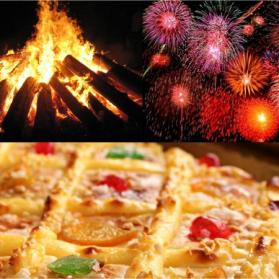The origins of the Verbena of Saint John (Night of Fire)
It is said that “When in Rome, do as the Romans do”, that is, when you are visiting another ountry, you should adapt to the traditions of the people in that country. A tradition settled in Spain is the celebration of the Night of Fire or Noche de San Juan, a festival that gathers family, neighbours or friends that meet up to have dinner, eat a traditional cake, light bonfires, light petards, play music and dance from the sunset of the 23rd of June until the dawn of the 24th, the day of San Juan (Saint John).
The Night of Fire goes long before Christianity, it is a festival where the protagonist is the fire, which cannot lack in a typical Night of San Juan. The big bonfires that are lit on the squares of the villages and cities come from a Pagan tradition where they were built to honour the Sun as a source of light and life at its peak, the 21st of June. The purpose of the bonfire was to give strength to the Sun after it reached its zenith, because after this day it enters a period of decline where the days start to shorten until the 21st of December, the winter solstice or the shortest day of the year. This Sun-worship custom of the Pagans was moved in the calendar to the night of the 23rd of June by the Catholic Church, who wanted to pair the festival with the date of birth of Saint John the Baptist.
It was during the Middle Ages when the bonfires begun to be complemented with petards, which gave to the festival noise besides light. The petards, as the gunpowder, were invented in China in the 9th century but while gunpowder had a warlike purpose, petards rapidly became a product of festive dimension and were used to make fireworks.
In Catalonia we have our traditional cake to celebrate the Night of San Juan: the coca de Sant Joan, a sweet bread-style sponge decorated with pine nuts and crystallized fruits and stuffed with a crème pâtissière. It is only sold in Catalonia around these dates! We eat it along with dessert wine or cava (Catalan sparkling wine). The coca de Sant Joan descends from a ring-shaped cake with eggs on the top, an allusion to the Sun.
